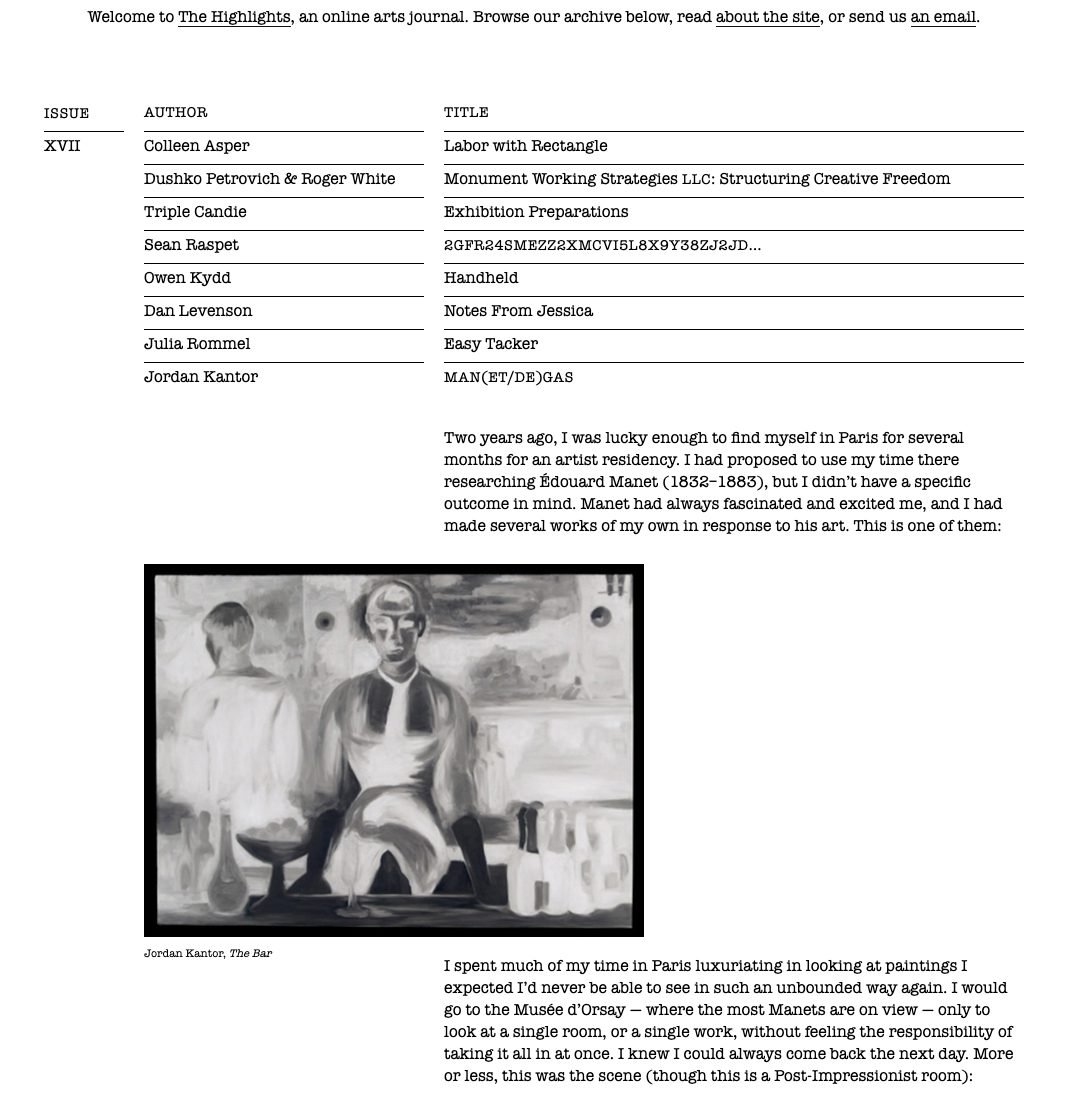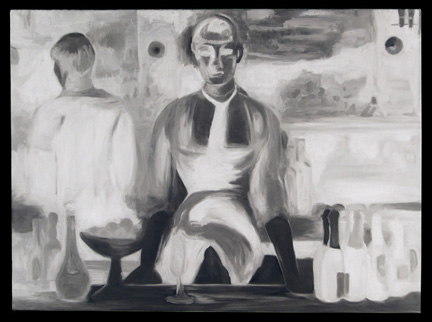
Jordan Kantor
MAN(ET/DE)GAS (2013)
Two years ago, I was lucky enough to find myself in Paris for several months on an artist’s residency. I had proposed to keep busy there researching Édouard Manet (1832-1883), but I didn’t have a specific outcome in mind. Manet had always fascinated and excited me, and I had made several works of my own in response to his art. This is one of them:

(Ill. 1 Kantor, The Bar)
I spent much of my time there luxuriating in looking at paintings I expected I’d never be able to see in such an unbounded way again. I would go to the Musée d’Orsay—where the most Manets are on view—only to look at a single room, or a single work, without feeling the responsibility of taking it all in at once. I always knew I could come back the next day. More or less, this was the scene (though this is the room with the Van Goghs):
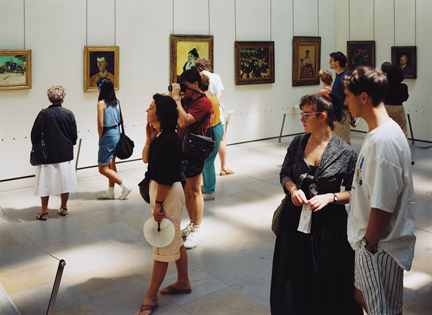
(ill. 2 Struth, Musée d’Orsay I)
Towards, the end of my trip, I started spending less time in the Musée d’Orsay’s galleries, and more time upstairs in its archives. There were shelves after shelves of museum boxes filled with documentation about Manet: installation shots of early exhibitions, condition reports, reams of contemporaneous cartoons mocking his work, correspondence with other artists, auction records, etc. etc. At this point, as my residency was winding down, I decided to turn from contemplation to action and switch into work mode. I began to photocopy the material in these boxes and figured I would parse the material later at home.
In one of the boxes—I think it was #48, labeled, “MANET Généralitiés Iconographie et Caricatures”—I found a black-and-white photograph of a portrait of “M. and Mme Édouard Manet” painted in 1868 or 1869 by Manet’s friend Edgar Degas. This is a scan of my photocopy of the photo of the Degas painting:
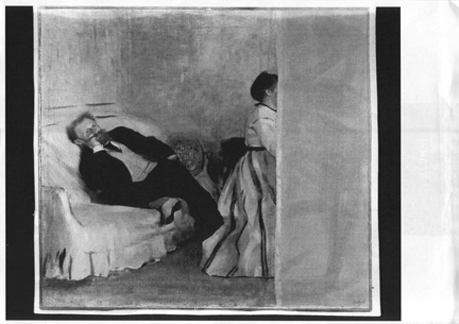
(Ill. 3 A4 photocopy)
The white border around the image (most conspicuous at right) bespeaks the difference between size of the 8 x 10 inch photograph (which came from a museum in Japan) and the 210 x 297 mm dimensions of the A4 sheet onto which it was photocopied at 100% scale. Like the photocopy, the painting itself has a strange border on the right edge.
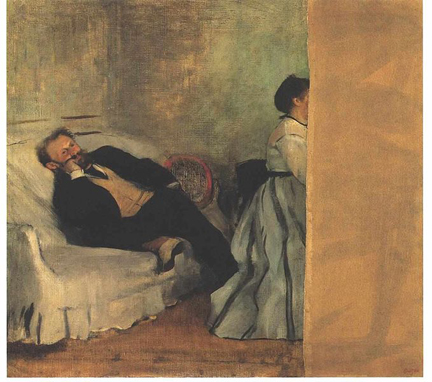
(Ill. 4 Degas, Portrait of M. and Mme. Manet)
It was only when I was back in the States and doing a little more research, that I learned more about that border, which appeared to be unpainted canvas. The following is from the Metropolitan Museum of Art’s Degas retrospective catalogue:
“The portrait of the Manets has attracted a great deal of attention because of the incident to which it gave rise. We are told Manet’s side of the story by Moreau-Nélaton and Degas’s side by Ambroise Vollard, both of whom were writing in the 1920s, long after the fact. Around the turn of the century, when he was visiting Degas in his studio one day, Vollard noticed ‘one of his canvases representing a man seated on a sofa and a woman on the side who had been cut in half vertically.’ (In a photograph from that same period showing Degas in his apartment with Bartholomé, we can see the double portrait on the wall next to Manet’s Ham, exactly as it would have looked to Vollard. Framed by a strip of dark wood with white or gilt beveling, it was not yet extended by the band of prepared canvas that Degas—no doubt intending, as he has said, to ‘restore’ Mme Manet—must have added a little later, because that is how it appeared in the first atelier sale.) Vollard’s account of the incident goes as follows:
Vollard: Who slashed that painting?
Degas: To think that it was Manet who did that! He thought that something about Mme Manet wasn’t right. Well … I’m going to try to ‘restore’ Mme. Manet. What a shock when I saw it at Manet’s … I left without saying goodbye, taking my picture with me. When I got home, I took down the little still life he had given me. ‘Monsieur,’ I wrote, ‘I am returning your Plums.’…”
That story has a lot in it.
As I understand it, Degas and Manet had traded paintings. Degas painted a portrait of Manet and his wife Suzanne, and Manet had given Degas a still life of plums in return. It seems Manet didn’t like the rendering of his wife, and had cut her out of the painting—a remarkable fact which begs further analysis on another occasion—and when Degas saw this at Manet’s house, he took the “edited” painting back. When, as if in retribution, Degas returned Manet’s Plums, he effectively undid their trade. For some time thereafter, Degas hung the altered portrait on his wall, next to another Manet still-life he owned, but, sometime after Vollard visited him, Degas extended the fragment with additional canvas, to make space to repaint the excised portion and “restore” Mme. Manet to the scene. Apparently, Degas never got to it, and the painting remains as it was upon his death: cropped by Manet, and waiting for Degas’s restoration.
Beyond this anecdote—which I find totally compelling in itself—were two things I especially liked about the painting. I liked the border, and the idea that the painting remains now forever unfinished. I also found how Degas chose to picture his friend compelling: casually, slouching on a sofa, one hand in pocket, and the other holding his cheek. Manet looked melancholy: pictured not as a man of action, but as a man of contemplation. The pose reminded me of an image by another artist I also greatly admire:
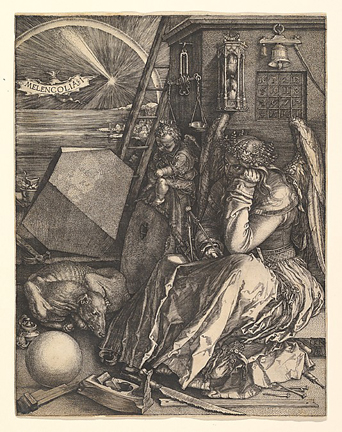
(Ill. 5 Dürer, Melencholia I)
(I don’t know, but I wouldn’t be surprised if Degas was intentionally quoting Dürer in this painting, hyper-conscious as he was of art’s histories.) It took a little longer for me to see that there was something, too, about my photocopy. I noticed how the border within the painting was echoed in the copy. The border was an index of my process of re-photography, and I wanted to try to make a work of my own out of that. It wasn’t until almost a year later that I set to it.
Again, I started with the photocopier. This time, because I was back in the United States, the image was further changed, even if ever so slightly. Once more, the right side of the image was altered: as the A4 format of the Musée d’Orsay copy was cropped to fit onto the standard 8- 1/2 x 11 inch paper that comes loaded in copiers here. I set up a system: I would continue to make copies—each a copy of the preceding copy—until something happened to the image. I wasn’t sure what would happen, or how long it would take, but I knew that copies progressively degrade the further away you get from the “original,” and I wanted to see what this looked like, when taken to its logical conclusion. It didn’t take too long to see changes. The image not only lost sharpness, but seemed to be sliding down, and to the right. Over a long series of generations of copies, the distortions of the process—only barely visible from one copy to the next—become more and more pronounced. This part of making the work was a relatively mindless process. I remember standing by the photocopier, lulled by the repetitiveness of the task, almost lost in a kind of reverie. I like to imagine that I had a far away look in my eyes similar to the one Degas captured in Manet’s as he listened to Suzanne at the piano she was so good at playing. I wonder if there is a connection is between repetition and melancholy? On the 166th generation copy, the image disappeared. It was like the photocopier ate the image.
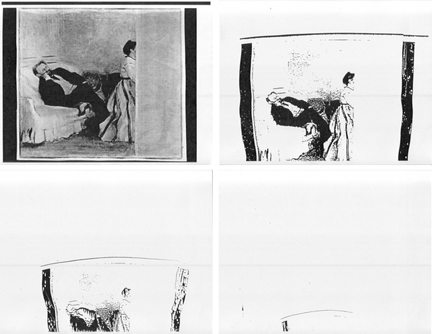
(Ill. 6. 4 stills)
I made two works from the resulting series of photocopies. The first is an artist’s book, which presents copies of the copies in the order in which they were made. It has black covers, a black fabric binding, and is in an open edition.
In the second work, I scanned each of the 166 photocopies into high resolution tiff files and put them into a moving image sequence. The resulting silent, black-and-white video is 18 seconds long.
(Ill. 7 Et De quicktime)
I titled the work “ET/DE.” I chose this title because “et” and “de” are the French words for “and” and “of,” and I regard my work as something very small and insignificant next to Manet and Degas, like a coordinating conjunction in a sentence in which they are the nouns. This highlights the relative invisibility of the work I did—concerned as it is with copying and the edges of things. I don’t particularly enjoy feeling that I am confined to such a minor role, but I think that is just how it is, especially when I choose to engage such towering figures. I also chose this title because “ET/DE” is itself cropping of sorts—as if excised from the coordinated pair “MAN(ET/DE)GAS.” Such a cropped title relates to the history of this particular image, and seems appropriate as a name for my intervention.
Beyond trying to shed some light on my initial intentions and describing my processes, I feel less and less comfortable these days analyzing the possible meanings of the work I do. I can say, however, that art is one way I try to reach out across time and space to commune with artists I greatly admire. I find this invigorating, even if most of the time, it feels I am only talking to myself.
--Jordan Kantor
Illustrations
1 Jordan Kantor, Untitled (The Bar), 2009. Chromogenic color print on metallic paper, mounted on gatorboard, 43 x 59 in.
2 Thomas Struth, Musée d’Orsay I, 1989. C-print, 59 1/4 x 71 in. (150.5 x 180.3 cm)
3 A4 photocopy
4 Edgar Degas, Monsieur et Madame Édouard Manet, 1868-69. Oil on canvas 65 x 71 cm. Kitakyushu Municipal Museum of Art, Japan.
5 Albrecht Dürer, Melencholia I, 1514. Engraving, 9 1/2 x 7 3/8 in. (24 x 18.5 cm).
6 still frames from Jordan Kantor, ET/DE, 2011. Digital video (black and white, silent), 0:18 min.
7 Jordan Kantor, ET/DE, 2011. Digital video (black and white, silent), 0:18 min.
Originally published in The Highlights, issue XVII (2013).
